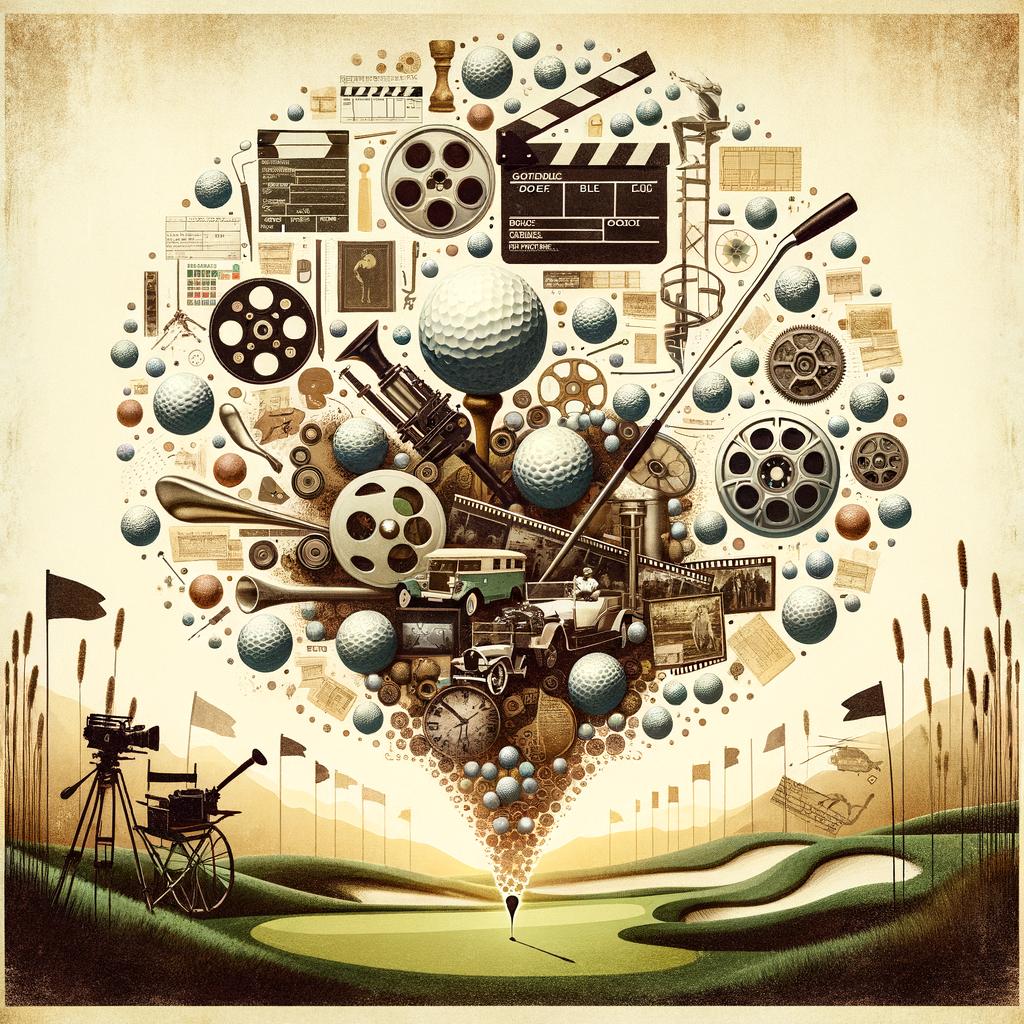Golf in Film: A Cultural Perspective
The fusion of sports and cinema has long provided a fertile ground for cultural examination, revealing insights into societal norms, ambitions, and the human experience. Among various sports depicted on screen, golf holds a unique place as both a symbol of leisure and exclusivity while also serving as a backdrop for deep narratives about personal challenges, friendship, and redemption. This article aims to dissect the complex portrayal of golf in film, shedding light on its cultural relevance within the broader context of cinematic history. By analyzing iconic films and memorable characters, we will investigate how golf mirrors societal views on wealth, success, and competition while also challenging these perceptions.
The Evolution of Golf in Cinema
The representation of golf in film has experienced significant transformation since cinema’s inception. Initially associated with themes of elitism and leisure—often showcased through the lens of upper-class lifestyles—early 20th-century films highlighted the sport’s elegance as an exclusive pursuit for the wealthy. This depiction mirrored contemporary socio-economic realities where access to golf courses was largely limited to affluent individuals.
As cinema evolved throughout the mid-20th century, narratives surrounding golf began to diversify significantly. Characters from varied backgrounds engaging with the sport opened new storytelling avenues. Comedic films like The Caddy (1953) and Happy Gilmore (1996) portrayed golf not just as a game requiring precision but also as an arena for personal development and connection. This shift reflects a democratization process where golfing became more relatable to wider audiences.
In modern cinema, portrayals have shifted again towards exploring individual struggles intertwined with human relationships against the backdrop of this sport. Themes such as perseverance and rivalry are prevalent; notable examples include Field of Dreams (1989) and The Greatest Game Ever Played (2005), which weave historical context with rich character arcs that position golf as a metaphor for hope and transformation.
Golf: A Reflection of Society and Class
The game itself embodies profound symbolism that reflects deeper social structures. Historically rooted within affluent circles, it serves not only as recreation but also highlights social stratification dynamics:
- Exclusivity: Golf courses often symbolize elitism; membership requirements reinforce social barriers.
- Cultural Tradition: The rituals surrounding play—from dress codes to etiquette—connect back to upper-class norms that elevate participants socially.
- Status Through Performance: Success on course is frequently seen as indicative not just of skill but one’s societal worth—a blend that intertwines personal achievement with public perception.
Cinematic representations illuminate these themes by showcasing characters navigating their journeys amid golfing landscapes—a stage ripe for conflict resolution or critique against societal expectations. Such narratives often juxtapose elite lifestyles against common aspirations through competition on greens.
Character Types in Golf Films
Centrally featured within golfing narratives are archetypal characters who reflect broader human experiences while entertaining audiences:
The“Reluctant Hero”, typically hesitant at first about engaging with golf due to personal conflicts or trauma ultimately finds healing through it—illustrating how this sport can serve transformative purposes beyond mere gameplay.
The“Stern Mentor”, representing seasoned expertise imparts wisdom regarding discipline or ethics associated with golfing culture; their guidance shapes protagonists’ journeys while reflecting traditional values amidst evolving modern contexts.
Cinematic Techniques: Capturing Golf’s Essence
Aesthetic portrayals transcend simple sporting events—they become visual poetry crafted by filmmakers using various techniques such as sweeping aerial shots highlighting expansive green landscapes alongside rugged terrains creating serene yet challenging atmospheres reflective of life’s complexities.
Slo-mo sequences dynamically enhance moments around pivotal shots transforming standard gameplay into riveting cinematic experiences inviting viewers deeper into emotional connections forged during playtime interactions between players themselves or nature surrounding them alike!
Future Directions for Representing Golf in Media
The changing media landscape presents fresh opportunities for reimagining how we depict golf onscreen! Recent trends indicate filmmakers increasingly recognize socio-economic dimensions tied closely together allowing exploration beyond traditional narratives previously established over decades past!
Future productions could spotlight underrepresented groups including women/minorities fostering inclusivity reflecting growing diversity present today across all levels involved within this beloved pastime!
Moreover expanding global perspectives enables storytellers worldwide access unique insights enriching overall narrative depth further enhancing appreciation toward multifaceted nature inherent throughout entire golfing experience itself!
By embracing diverse voices collaborating across cultures creators can craft compelling stories emphasizing communal ties competition growth ultimately presenting us something far greater than just another game—it becomes symbolic canvas illustrating complexities found everywhere around us!
Conclusions About Golf’s Cinematic Representation
Through examining representations found throughout various films featuring this timeless activity one gains insight into cultural identities shaping our understanding regarding aspirations class dynamics resilience faced daily by individuals navigating life’s challenges ahead! Future research may continue exploring evolving depictions considering contemporary shifts influencing portrayal styles emerging today offering fertile ground ongoing academic inquiry.

Swinging Through Society: Unpacking Golf’s Cultural Impact in Film
Meta Title
Exploring Golf’s Cultural Influence in Film | Golf Swing Society
Meta Description
Discover the profound impact of golf on film culture. Explore iconic movies, notable moments, and the influence of golf on societal norms.
The Cultural Significance of Golf in Film
Golf, often viewed as a leisurely sport, has transcended beyond greens and fairways to become a prominent cultural symbol in films. The sport’s intersection with storytelling highlights values such as competition, camaraderie, and personal growth. From classic films to modern blockbusters, golf’s representation serves as a lens through which societal themes are explored.
Iconic Golf Films
Several films have prominently featured golf, showcasing its allure and underlying messages.
1. Caddyshack (1980)
One of the most beloved golf comedies of all time, Caddyshack blends humor and the competitive spirit of the game. With memorable characters like Carl Spackler and Ty Webb, the movie echoes themes of class struggle, ambition, and friendship.
- Cultural Impact:
– Humor in golf
– Portrayal of golf club culture
2. The Legend of Bagger Vance (2000)
Based on the novel by Steven Pressfield, this film intertwines golf with philosophical themes and personal redemption. Starring Matt Damon, Will Smith, and Charlize Theron, it highlights the concept of “finding your authentic swing.”
- Cultural Impact:
– Emphasis on inner peace and focus
- Reflection on the Great Depression era
3. Tin Cup (1996)
This romantic comedy-drama showcases the journey of an unorthodox golf pro, played by Kevin Costner, who attempts to qualify for the U.S. Open. The film emphasizes determination, risk-taking, and the personal quest for greatness.
- Cultural Impact:
– The struggle against odds
– Love and golf as intertwined pursuits
Golf and Societal Themes
Golf in film often reflects broader societal issues and evolving cultural narratives. Here is a closer look at some themes reflected in golf-related films:
Accountability and Redemption
Many films utilize golf as a metaphor for personal growth. Characters often face challenges that require them to reevaluate their choices, leading to moments of self-discovery.
- Example: In The Legend of Bagger Vance, characters confront their demons, paralleling their performance on the golf course with their emotional journeys.
Class and Social Status
The sport of golf has historical ties to affluence, making it an ideal backdrop to explore class disparity. Films like Caddyshack critique societal norms and the exclusivity often associated with golf clubs.
- Example: The juxtaposition of characters from different social backgrounds raises questions about privilege and access to sports.
The Influence of Golf on Pop Culture
Golf’s influence extends beyond cinema into various realms of pop culture, shaping perceptions and trends.
Fashion and Attire
The classic golf attire, characterized by polo shirts, khakis, and caps, has seeped into mainstream fashion. Films featuring golf inspire audiences to adopt similar styles, merging sport with contemporary fashion.
- Fun Fact: The “preppy” style made popular by golf films has made golf clothing a staple in casual wardrobes.
Language and Expressions
Golf-related terms and phrases have entered everyday language, often used to describe tactics and strategies in various contexts. Phrases like “swing for the fences” or “tee it up” have gained mainstream popularity, making the sport a linguistic cultural touchstone.
Case Studies: Golf’s Role in Character Development
Character Arcs Influenced by Golf
Golf often serves as the backdrop for character development, highlighting transformative journeys.
| Film | Character | Golf Influence | Character Arc |
|———————-|——————|———————————-|————————————–|
| Caddyshack | Ty Webb | Mastery and confidence | Overcoming superficiality |
| The Legend of Bagger Vance | Rannulph Junuh | Finding peace and redemption | Growth from self-doubt to clarity |
| Tin Cup | Roy McAvoy | Pursuit of personal glory | Embracing failure and acceptance |
Practical Tips for Golf Enthusiasts
To fully appreciate the cultural nuances of golf in film, consider the following practical tips:
- Widen Your Viewing: Explore diverse golf films, from comedies to dramas, to understand the multifaceted representation of the sport.
- Join a Community: Engage with local golf clubs or online forums where you can discuss film perspectives and share personal experiences related to golf.
- Embrace the Culture: Attend golf events or watch major tournaments to see how the themes presented in films reflect real-life golf culture.
First-Hand Experience: The Appeal of Golf Films
Many golf enthusiasts resonate deeply with the themes portrayed in films. Their narratives reflect personal experiences and challenges faced both on and off the course.
- Personal Reflection: As a golfer, movies like Tin Cup inspire me to embrace failure and keep pushing my limits. The quest for improvement is a journey shared by many, both in competitions and personal life.
Golf’s Cultural Footprint in Society
Golf’s portrayal in films serves as a microcosm of broader societal issues and aspirations. The interplay of character development, social dynamics, and personal journeys makes golf an effective storytelling device.
Conclusion
The cultural impact of golf in film is vast and multifaceted, shaping perceptions and societal norms. Iconic films not only entertain but also challenge audiences to reflect on deeper personal and societal issues. Engaging with these narratives can enhance your appreciation for the sport and its significance in our lives.
This exploration showcases how deeply golf is embedded in the cultural fabric through film, influencing everything from personal growth narratives to societal observations. Immerse yourself in these cinematic experiences to better understand the interplay between golf and culture.





